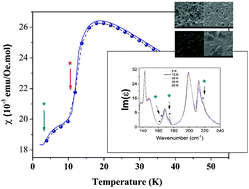Synthesis and characterisation of the vibrational and electrical properties of antiferromagnetic 6L-Ba2CoTeO6 ceramics†
Abstract
Optimal processing conditions for fabrication of dense single-phase 6L-Ba2CoTeO6 ceramics via the solid-state reaction method were determined. These ceramics possess a room-temperature crystal structure described by the centrosymmetric P![[3 with combining macron]](https://www.rsc.org/images/entities/char_0033_0304.gif) m1 space group. Polarized Raman spectroscopy enabled the observation of all the 25 predicted Raman modes and assignment of their symmetries. On cooling, BCTO ceramics exhibit two antiferromagnetic transitions at 3 K and 12.5 K, in broad agreement with a recent single-crystal study [P. Chanlert, N. Kurita, H. Tanaka, D. Goto, A. Matsuo and K. Kindo, Phys. Rev. B: Condens. Matter Mater. Phys., 2016, 93, 094420]. Low temperature Fourier-transform infrared reflectivity analyses suggest the antiferromagnetic phase transitions to be driven by small distortions of the CoO6 octahedra, lowering locally their C3v symmetry. This causes splitting of the associated vibrational modes, but without a long-range structural change. AC impedance spectroscopy revealed BCTO ceramics to be leaky insulators with an activation energy for conduction of ∼0.15−0.25 eV, which suggests electron hopping between mixed oxidation states of Co.
m1 space group. Polarized Raman spectroscopy enabled the observation of all the 25 predicted Raman modes and assignment of their symmetries. On cooling, BCTO ceramics exhibit two antiferromagnetic transitions at 3 K and 12.5 K, in broad agreement with a recent single-crystal study [P. Chanlert, N. Kurita, H. Tanaka, D. Goto, A. Matsuo and K. Kindo, Phys. Rev. B: Condens. Matter Mater. Phys., 2016, 93, 094420]. Low temperature Fourier-transform infrared reflectivity analyses suggest the antiferromagnetic phase transitions to be driven by small distortions of the CoO6 octahedra, lowering locally their C3v symmetry. This causes splitting of the associated vibrational modes, but without a long-range structural change. AC impedance spectroscopy revealed BCTO ceramics to be leaky insulators with an activation energy for conduction of ∼0.15−0.25 eV, which suggests electron hopping between mixed oxidation states of Co.



 Please wait while we load your content...
Please wait while we load your content...